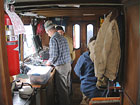

 | |||||||
|
|
Journals 2005/2006Jeff Manker
August 19, 2005 Today we tested our equipment out at sea. The team spent many hours getting software to work, computers and instruments to talk to each other and figuring out how to safely lower and raise instruments into and out of the water. The weather made it a little rough, with 5 to 10 foot seas and a wind that cut like a knife. There may be blistering heat in the lower 48 right now, but summer up here means an average high of 40°F and lows in the thirties. As we headed out of our protective lagoon anchorage the sky cleared enough for a short period of sunshine. On the way back in we were pounding against the short seas and our EPIRB (Emergency Position Indicating Radio Beacon) sent out a distress signal without our knowing it. A Swedish icebreaker was asked by the Coast Guard to go check us out with their helicopter. As we were heading in, the chopper came very close - we thought they were just trying to say hello, so we waved and they flew away. Later we found out that the lid of the EPIRB had been re-installed backwards by the manufacturer and water had gotten in, setting it off. There are five main pieces of equipment that are being deployed off the boat: the Acrobat, the ADCP, the CTD rosette, the Bongo nets and the VPR. Each of these platform vehicles performs several duties. The Acrobat is towed behind the ship and moves up and down in the water column via its wings. On board it caries a CTD (Conductivity which measures salinity, Temperature, Depth) meter and a Fluorometer - which measures the amount of chlorophyll or photosynthetic plankton in the water. The ADCP (Acoustic Doppler Current Profiler) is lowered off the side of the boat where it rides a few feet below the surface. By reflecting sound waves off of tiny particles in the water, the ADCP can determine the speed and direction of currents and provide a profile from just below the surface to the bottom of the water column. The CTD Rosette carries a CTD meter, a fluorometer, a PAR sensor (Photosynthetically Available Radiation) that records the amount of light that is useful to photosynthesizing organisms at different depths and Niskin bottles- used to collect seawater at predetermined depths for later analysis (more on this later). The Bongo nets are plankton nets of two different size mesh (53µm and 150µm). The long cylindrical nets are lowered over the stern and pulled behind the boat trapping plankton of all types and sizes which are removed from the "cod ends" (removable, heavy plastic collectors at the tail end of the nets) when the net is retrieved. The VPR ("Viper") is a Video Plankton Recorder. This amazing piece of equipment is towed behind the boat at varying depths where as water flows past the two arms a strobe light fires at sixty times a second and any organism between the arms gets its picture recorded. The computer then sorts through the images looking for those in focus and then runs a recognition software program to identify the plankton! All of this equipment has to be linked to computers and GPS (global positioning system) to interpret the data. |
||||||






